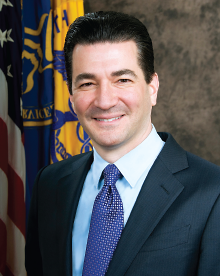The FDA is tackling the opioid epidemic by promoting development of new medications, encouraging wider use of existing medication-assisted treatment (MAT), and convening a panel to promote insurance coverage for MAT.
“Everyone who seeks treatment for an opioid use disorder should be offered access to all three options” for the treatment of opioid use disorder—buprenorphine, methadone, and naltrexone, said Commissioner of Food and Drugs Scott Gottlieb, M.D., in a statement released last November 30. “All three of these treatments have been demonstrated to be safe and effective in combination with counseling and psychosocial support.”
These drugs stabilize brain chemistry, reduce or block the euphoric effects of opioids, relieve cravings, and normalize body functions. In fact, patients receiving MAT cut their risk of death from all causes in half, according to the Substance Abuse and Mental Health Services Administration (SAMHSA).
In 2016, 21 million Americans needed treatment for a substance use disorder, but only 3.8 million received any form of treatment, according to SAMHSA’s National Survey on Drug Use and Health. Just over 2 million Americans had an opioid use disorder.
Gottlieb called private coverage “often inadequate” and pointed out that many state Medicaid programs are still not covering MAT. For instance, only 31 states included methadone or extended-release naltrexone on their Medicaid preferred drug lists for 2013, according to SAMSHA. Only 13 states included all six medications for the treatment of alcohol use and opioid use disorders on their lists.
Gottlieb called it “astonishing” that very few criminal justice systems offer access to the three medications for opioid use disorder and said these systems are thus raising the risk of overdose deaths for inmates upon their release.
Gottlieb said that the FDA is planning to convene a panel to review the evidence that supports the effectiveness of MAT in the hopes of encouraging more health insurance plans to cover it. Also, he said that the FDA is developing a protocol “to support a claim that availability of MAT at the point of care—when a patient presents with overdose—could lead to reduction in death.” Often there is a lag of several weeks before treatment is begun.
Last September, the FDA revised labeling on buprenorphine products to emphasize the evidence that long-term or even lifelong use of medication may be needed for patients to achieve sustained recovery. The agency is now re-evaluating the labels of methadone and naltrexone to ensure they reflect current science on duration of use.
The FDA is also working to facilitate the development of new medications and new formulations, Gottlieb said, and intends to provide a framework to develop a validated measurement of “cravings.”
Barriers Prevent Widespread MAT Use
“I think it’s wonderful that the FDA is focusing on this particular problem and issue. It shows that this FDA understands the pressing needs of this population,” said Andrew J. Saxon, M.D., a professor of psychiatry at the University of Washington and chair of APA’s Council on Addiction Psychiatry.
Saxon said that the development of new medications could add to the treatment arsenal, especially for patients who have not been helped by existing treatments. However, he emphasized, “We need a two-pronged approach: not just to look for new and different medications, but also to get the medications we already have to the people who need them urgently.”
Saxon said not all new formulations have proved practical. Although it took many years to gain approval for the subdermal form of buprenorphine, which occurred last June, its implantation requires a surgical procedure by specially trained physicians, and it is indicated only for patients who are stable on a low to moderate dose of sublingual buprenorphine—already a convenient form of the drug.
Many barriers stand in the way of wider adoption of MAT, Saxon added, even though studies show that their use outweighs the costs. One report found that every $100,000 spent on treatment saves $487,000 on health care and avoids $700,000 in costs related to crime. But Medicaid restrictions limit availability of MAT, such as prior authorization rules, quantity limits, and lifetime treatment limits.
Some conditions for treatment may be well intentioned, but not rooted in science and thus present barriers to care, Saxon said, such as the requirement that patients attend counseling while on MAT. “The intention was good—to get people more help. But for a lot of people, that’s a time commitment and expense they can’t afford. Evidence indicates that for most patients, the medication is doing 80 percent of the treatment. Adding a counseling requirement, when it contributes little, is just creating an unnecessary hurdle.”
Stigma, too, plays a huge role in limiting patients’ access to these treatments, Saxon said. When it comes to cancer treatments that may extend life by only three to six months and cost thousands of dollars, no one objects, he said. “But when it comes to opioid use disorder, with treatments that can prolong life for a very long time, people seem to be very worried about how much they cost,” he said.
Saxon likened lifetime limits to telling type 2 diabetics that after two years they should be taken off all their medications. Few will succeed with such an approach. Meanwhile, MAT provides very dramatic benefit, he said. Without treatment, individuals with opioid use disorder have seven to 10 times the mortality rate of the general population. With treatment, their risk of death drops to just 2 times the risk of the general population. ■
The “Statement From FDA Commissioner Scott Gottlieb, M.D., on the Approval of a New Formulation of Buprenorphine and FDA’s Efforts to Promote More Widespread Innovation and Access to Opioid Addiction Treatments” can be accessed
here.

